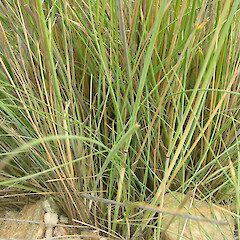Anthosachne aprica
Common name
blue wheat grass
Synonyms
Elymus apricus Á.Löve et Connor
Family
Poaceae
Flora category
Vascular – Native
Endemic taxon
Yes
Endemic genus
No
Endemic family
No
Structural class
Grasses
NVS code
The National Vegetation Survey (NVS) Databank is a physical archive and electronic databank containing records of over 94,000 vegetation survey plots - including data from over 19,000 permanent plots. NVS maintains a standard set of species code abbreviations that correspond to standard scientific plant names from the Ngä Tipu o Aotearoa - New Zealand Plants database.
ANAAPR
Chromosome number
2n = 42
Current conservation status
The conservation status of all known New Zealand vascular plant taxa at the rank of species and below were reassessed in 2017 using the New Zealand Threat Classification System (NZTCS) – more information about this can be found on the NZTCS website. This report includes a statistical summary and brief notes on changes since 2012 and replaces all previous NZTCS lists for vascular plants.
Please note, threat classifications are often suggested by authors when publications fall between NZTCS assessment periods – an interim threat classification status has not been assessed by the NZTCS panel.
- Conservation status of New Zealand indigenous vascular plants, 2017 . 2018. Peter J. de Lange, Jeremy R. Rolfe, John W. Barkla, Shannel P. Courtney, Paul D. Champion, Leon R. Perrie, Sarah M. Beadel, Kerry A. Ford, Ilse Breitwieser, Ines Schönberger, Rowan Hindmarsh-Walls, Peter B. Heenan and Kate Ladley. Department of Conservation. Source: NZTCS and licensed by DOC for reuse under the Creative Commons Attribution 4.0 International licence.
2017 | At Risk – Naturally Uncommon | Qualifiers: DP, Sp
Previous conservation statuses
2012 | At Risk – Naturally Uncommon | Qualifiers: Sp
2009 | At Risk – Naturally Uncommon
2004 | Range Restricted
Distribution
Endemic. South Island, Central Otago only
Habitat
A species of inland basins where it grows in short tussock (Festuca novae-zelandiae (Hack.) Cockayne) grasslands at elevations of 150–200 m.
Detailed description
Erect, glaucous, and tufted. Leaf-sheath 70-100 mm, keeled striate, becoming fibrous, glabrous, sparsely hairy or pubescent, margins papery. Ligule 0.3–0.5 mm, ciliate. Leaf-blade 200–300 × 2–4 mm, glaucous, flat, ribbed, sometimes involute, upper surface glabrous, or with occasional 1 mm long hairs, undersides densely hairy, lamina margin prickle-toothed, occasionally with sparse hairs up to 1 mm long. Culms 0.5–1 m, erect, nodes conspicuous, black or red-brown. Inflorescences 180–250 mm, stiff, erect, of 3–7 spreading spikelets. Spikelets 30–50 mm, each with 6–12 (or more) florets. Glumes ± equal, 5–10 mm, 3-nerved, acute or shortly awned, margins papery, ciliate. Lemma 10–14 mm, glabrous with some prickle-teeth above, apex occasionally bifid, awn 22–45 mm, recurved or straight. Palea 6–13 mm, apex bifid. Rachilla 2–3 mm, short stiff hairy. Callus 0.75 mm, incompletely and shortly bearded. Anthers 4–9 mm purple or yellow.
Manaaki Whenua Online Interactive Key
Similar taxa
Morphologically superficially similar to Connorochloa tenuis, from which it differs by the erect culms rather than long trailing culms, with the uppermost internodes short, spikelets widely spreading (divergent) from rachis, and 4–9 mm long, purple to yellow anthers. Anthosachne aprica is a stout grass with conspicuous erect flower heads bearing long-awned spikes that are held at a distinct angle to the stem. Aside from Connorochloa it could possibly can be confused with some exotic Bromus spp. that also have long awns (but these often have hairy leaves, and green rather than blue-green coloured spikes, and the edges of the spikes are sharply delineated, not rounded as in Anthosachne. This species previously regarded as an Elymus is now accepted as a member of Anthosachne (see Barksworth & Jacobs (2011)).
Flowering
October–February.
Flower colours
Violet/Purple, Yellow
Fruiting
November–April
Life cycle
Florets are dispersed by wind and attachment (Thorsen et al., 2009).
Propagation technique
Easy from fresh seed and the division of whole plants. Dislikes humidity and does best in full sun, in a well drained soil.
Threats
A local endemic, that while not believe to be threatened occupies a very narrowly defined range that is ever increasingly vulnerable to loss of habita through the expansion of the wine industry in Central Otago.
Etymology
aprica: From the Latin aperire ‘open’, meaning uncovered
Where to buy
Not commercially available.
Attribution
Fact sheet prepared for NZPCN by P.J. de Lange June 2005. Feature description adapted from Edgar & Connor (2000).
References and further reading
Barkworth ME, Jacobs SWL. 2011: The Triticeae (Gramineae) in Australasia. Telopea 13: 37–56.
Edgar E, Connor HE. 2000. Flora of New Zealand. Vol. V. Grasses. Christchurch, Manaaki Whenua Press. 650 p.
Thorsen MJ, Dickinson KJM, Seddon PJ. 2009. Seed dispersal systems in the New Zealand flora. Perspectives in Plant Ecology, Evolution and Systematics 11: 285–309.
NZPCN Fact Sheet citation
Please cite as: de Lange, P.J. (Year at time of access): Anthosachne aprica Fact Sheet (content continuously updated). New Zealand Plant Conservation Network. https://www.nzpcn.org.nz/flora/species/anthosachne-aprica/ (Date website was queried)




